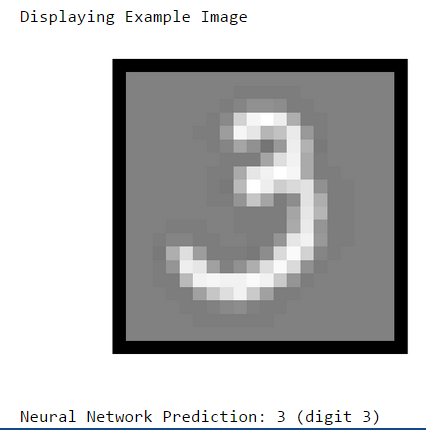一、多元分类
1.1 数据集
本次实现的是手写数字的识别,数据集中有5000个样本,其中每个样本是20*20像素的一张图片,每个像素都用一个点数来表示,该点数表示这个位置的灰度,将20*20的像素网络展开为400维向量,而训练集中的5000*400的矩阵,每一行就代表了一个手写数字图像的灰度值。
训练集的第二部分是5000维向量y,包含训练集的标签,为了与没有0索引的MATLAB索引兼容,我们将数字零映射到10,因此,\ 0“数字被标记为\ 10”,而数字\ 1“至\ 9”则按照其自然顺序被标记为\ 1“至\ 9”。
1.2 可视化数据
可视化数据的代码已经完成,运行可以看到随机从数据集中挑选出来的100个数字
数据可视化函数:
function [h, display_array] = displayData(X, example_width)
%DISPLAYDATA Display 2D data in a nice grid
% [h, display_array] = DISPLAYDATA(X, example_width) displays 2D data
% stored in X in a nice grid. It returns the figure handle h and the
% displayed array if requested.
% Set example_width automatically if not passed in
if ~exist('example_width', 'var') || isempty(example_width)
example_width = round(sqrt(size(X, 2)));
end
% Gray Image
colormap(gray);
% Compute rows, cols
[m n] = size(X);
example_height = (n / example_width);
% Compute number of items to display
display_rows = floor(sqrt(m));
display_cols = ceil(m / display_rows);
% Between images padding
pad = 1;
% Setup blank display
display_array = - ones(pad + display_rows * (example_height + pad), ...
pad + display_cols * (example_width + pad));
% Copy each example into a patch on the display array
curr_ex = 1;
for j = 1:display_rows
for i = 1:display_cols
if curr_ex > m,
break;
end
% Copy the patch
% Get the max value of the patch
max_val = max(abs(X(curr_ex, :)));
display_array(pad + (j - 1) * (example_height + pad) + (1:example_height), ...
pad + (i - 1) * (example_width + pad) + (1:example_width)) = ...
reshape(X(curr_ex, :), example_height, example_width) / max_val;
curr_ex = curr_ex + 1;
end
if curr_ex > m,
break;
end
end
% Display Image
h = imagesc(display_array, [-1 1]);
% Do not show axis
axis image off
drawnow;
end
调用显示函数:
% Load Training Data
fprintf('Loading and Visualizing Data ...\n')
load('ex3data1.mat'); % training data stored in arrays X, y
m = size(X, 1);
% Randomly select 100 data points to display
rand_indices = randperm(m);
sel = X(rand_indices(1:100), :);
displayData(sel);
fprintf('Program paused. Press enter to continue.\n');
pause;
运行结果:

1.3 向量化logistic回归
1.3.1 向量化代价函数
从向量化代价函数开始,logistic回归的代价函数是: ,为了求和,我们要计算每个样本i的
,为了求和,我们要计算每个样本i的![]() ,而
,而![]() ,
,![]() 是sigmoid函数。
是sigmoid函数。
我们定义X和θ为:
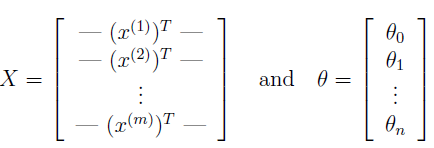
然后计算矩阵乘法Xθ,等于
 (注意这里运用了向量运算的法则
(注意这里运用了向量运算的法则![]() )
)
这使得我们计算所有样本的![]() 时只要使用一行代码即可。
时只要使用一行代码即可。
1.3.2 向量化梯度
回顾一下非正则化逻辑回归成本函数的梯度是一个向量,其中第J个元素定义为![]() ,我们写出所有
,我们写出所有![]() 的偏导数:
的偏导数:

理解一下上述推导中的最后一步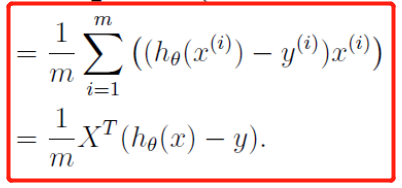 ,我们定义
,我们定义![]() ,于是可以得到:
,于是可以得到:

1.3.3 向量化正则化的逻辑回归
完成logistic回归的向量化后,这时候往代价函数中增加正则化项,之前学过,正则化的logistic回归的代价函数为:
![]() (注意θ0不需要正则化,因为它是用来控制偏置项的)
(注意θ0不需要正则化,因为它是用来控制偏置项的)
正则化的logistic回归的代价函数偏导数定义为:

完成lrcostfunction.m中的代码,要使用元素乘法和求和函数sum:
function [J, grad] = lrCostFunction(theta, X, y, lambda) %LRCOSTFUNCTION Compute cost and gradient for logistic regression with %regularization % J = LRCOSTFUNCTION(theta, X, y, lambda) computes the cost of using % theta as the parameter for regularized logistic regression and the % gradient of the cost w.r.t. to the parameters. % Initialize some useful values m = length(y); % number of training examples % You need to return the following variables correctly J = 0; grad = zeros(size(theta)); % ====================== YOUR CODE HERE ====================== % Instructions: Compute the cost of a particular choice of theta. % You should set J to the cost. % Compute the partial derivatives and set grad to the partial % derivatives of the cost w.r.t. each parameter in theta % % Hint: The computation of the cost function and gradients can be % efficiently vectorized. For example, consider the computation % % sigmoid(X * theta) % % Each row of the resulting matrix will contain the value of the % prediction for that example. You can make use of this to vectorize % the cost function and gradient computations. % % Hint: When computing the gradient of the regularized cost function, % there're many possible vectorized solutions, but one solution % looks like: % grad = (逻辑回归未正则化的梯度) % temp = theta; % temp(1) = 0; % because we don't add anything for j = 0 % grad = grad + YOUR_CODE_HERE (使用temp变量) hy = sigmoid(X*theta); J = sum(-y.*log(hy) - (1-y).*log(1-hy))/m; % 计算未正则化的代价函数 diff = hy - y; grad = X'*diff/m; % 未正则化的梯度 J = J + sum(theta(2:end).^2)*lambda/(2*m); % 正则化后的代价函数(theta从第二个开始) temp = theta; temp(1) = 0; grad = grad + temp*(lambda/m); % ============================================================= grad = grad(:); end
运行得到的结果:

1.4 一对多分类
训练多个正则逻辑回归分类器实现一对多分类,在给出的手写数字数据集中,类别K=10,而我们编写的代码应该适用于任何K值
tip:MATLAB中,向量a(m*1)和标量b进行a==b的运算,将会得到一个和a相同size的向量,代码示例如下:
>> a =1:10
a =
1 2 3 4 5 6 7 8 9 10
>> b=3
b =
3
>> a==b
ans =
1×10 logical 数组
0 0 1 0 0 0 0 0 0 0
完成oneVSall.m中的代码:
function [all_theta] = oneVsAll(X, y, num_labels, lambda) %ONEVSALL trains multiple logistic regression classifiers and returns all %the classifiers in a matrix all_theta, where the i-th row of all_theta %corresponds to the classifier for label i
% ONEVSALL训练多个逻辑回归分类器,并以矩阵all_theta返回所有分类器,其中all_theta的第i行对应于标签i的分类器
% [all_theta] = ONEVSALL(X, y, num_labels, lambda) trains num_labels
% logistic regression classifiers and returns each of these classifiers
% in a matrix all_theta, where the i-th row of all_theta corresponds
% to the classifier for label i
% Some useful variables
m = size(X, 1); % 返回X矩阵的第一个维度(行)数
n = size(X, 2); % 返回X矩阵的第二个维度(列)数
% You need to return the following variables correctly
all_theta = zeros(num_labels, n + 1);
% Add ones to the X data matrix 给X矩阵加上一列1
X = [ones(m, 1) X];
% ====================== YOUR CODE HERE ======================
% Instructions: You should complete the following code to train num_labels
% logistic regression classifiers with regularization
% parameter lambda.
%
% Hint: theta(:) will return a column vector.
%
% Hint: You can use y == c to obtain a vector of 1's and 0's that tell you
% whether the ground truth is true/false for this class.
%
% Note: For this assignment, we recommend using fmincg to optimize the cost
% function. It is okay to use a for-loop (for c = 1:num_labels) to
% loop over the different classes.
%
% fmincg works similarly to fminunc, but is more efficient when we
% are dealing with large number of parameters.
% 在这里我们使用fmincg函数来优化代价函数,fmincg和fminunc基本相同,但是前者处理大量数据效率更高
% Example Code for fmincg:
%
% % Set Initial theta
% initial_theta = zeros(n + 1, 1);
%
% % Set options for fminunc
% options = optimset('GradObj', 'on', 'MaxIter', 50);
%
% % Run fmincg to obtain the optimal theta
% % This function will return theta and the cost
% [theta] = ...
% fmincg (@(t)(lrCostFunction(t, X, (y == c), lambda)), ...
% initial_theta, options);
%
% options = optimset('GradObj', 'on', 'MaxIter', 50);
%
% for c = 1:num_labels
% initial_theta = zeros(n+1, 1);
% all_theta(c,:) = fmincg(@(t)(lrCostFunction(t, X, (y==c), lambda)), initial_theta, options);
% end
for c=1:num_labels
initial_theta = zeros(n+1,1);
options = optimset('GradObj', 'on', 'MaxIter', 50);
%调用fmincg库函数求出所有分类器的θ向量
[theta] = ...
fmincg (@(t)(lrCostFunction(t, X, (y == c), lambda)), ...
initial_theta, options);
%将每个θ放入all_theta的每一行中
all_theta(c,:) = theta';
% ========================================================================= end
运行结果:

num_labels 为分类器个数,共10个,每个分类器(模型)用来识别10个数字中的某一个。
我们一共有5000个样本,每个样本有400个特征变量,因此:模型参数θ向量有401个元素。
initial_theta = zeros(n+1,1); % 模型参数θ的初始值(n == 400)
all_theta是一个10*401的矩阵,每一行存储着一个分类器(模型)的模型参数θ向量,执行上面for循环,就调用fmincg库函数求出了所有模型的参数θ向量了。
1.4.1 一对多预测
训练完分类器以后,可以使用它来预测图像代表的数字,对于每个输入,使用经过训练的逻辑回归分类器来计算属于每个类别的概率,最后输出概率最高的一个作为预测的结果。
完成predictOneVsAll.m中的代码:
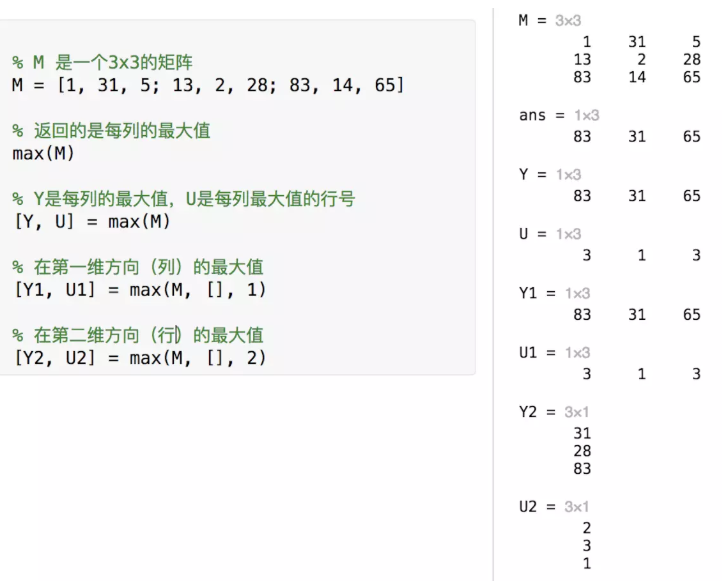
function p = predictOneVsAll(all_theta, X) m = size(X, 1); num_labels = size(all_theta, 1); % 定义num_labels为all_theta矩阵的行数(本例中为10) % You need to return the following variables correctly p = zeros(size(X, 1), 1); % Add ones to the X data matrix X = [ones(m, 1) X]; [x,p] = max(sigmoid(X*all_theta'),[],2); %返回的p为预测函数中最大值的行号 end
调用函数,看一下预测准确率:
pred = predictOneVsAll(all_theta, X);
fprintf('\nTraining Set Accuracy: %f\n', mean(double(pred == y)) * 100);
输出结果:

2. 神经网络
2.1 模型表示
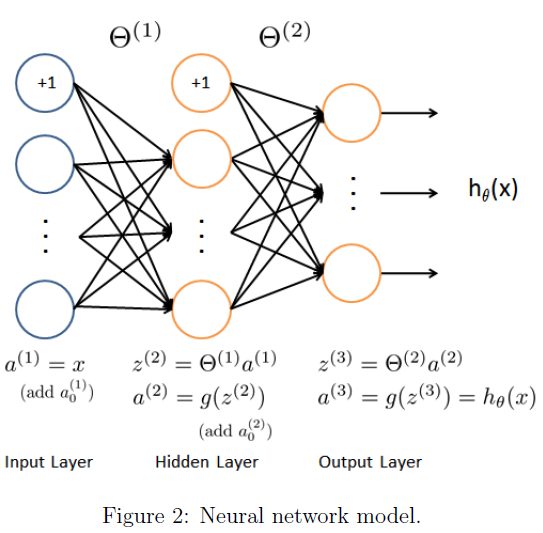
本神经网络中,参数已经训练完并给出,只需要加载到theta_1和theta_2中,该神经网络在第二层有25个单位,在输出层有10个单位,完成predict.m中的代码
function p = predict(Theta1, Theta2, X) % Useful values m = size(X, 1); num_labels = size(Theta2, 1); % You need to return the following variables correctly p = zeros(size(X, 1), 1); a1 = [ones(m, 1) X]; % 输入层 a1是X前加一列 a2 = [ones(m,1) sigmoid(a1 * Theta1')]; % 隐藏层 a2是用theta_1计算出的第二层 [x, p] = max(sigmoid(a2 * Theta2'), [], 2); % 输出层 end
预测结果:

